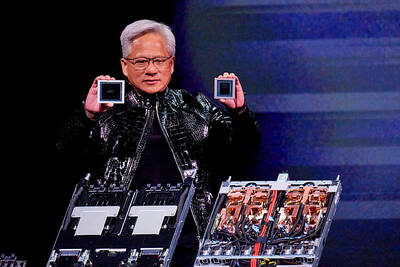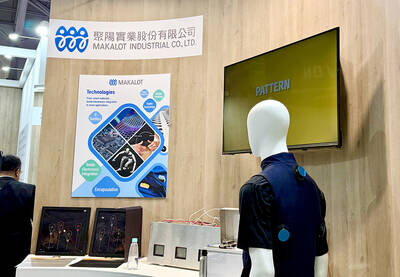Electronic components maker Lite-On Technology Corp (光寶科技) yesterday reported that first-quarter net profit rose 7.3 percent from a year earlier to NT$1.57 billion (US$52.42 million), despite the impact from the COVID-19 pandemic.
While revenue dropped 20.88 percent on an annual basis to NT$32.58 billion due mainly to a production halt in China, its gross margin climbed to a seven-year high of 14.5 percent, thanks to an improved product mix and operating efficiency, the company said.
“The gross margin would be 0.2 percentage points higher if we do not take into account losses incurred by subsidiary Silitech Technology Corp (閎暉),” Lite-On vice chairman and chief operating officer Warren Chen (陳廣中) told investors at an earnings conference in Taipei, adding that the company’s performance was affected by continuous losses from its solid-state drive (SSD) business.
Sale of the SSD unit to Japan’s Kioxia Holdings Corp was delayed by the pandemic, but the deal is expected to close by the end of this quarter, Chen said.
Giving a rosy outlook for business this quarter, Chen said the company is operating at full capacity across its plants in China to satisfy customers’ mass orders.
“Clients are pressing us everyday [because] the market is undersupplied, with sales channels empty,” Chen said.
The company forecast an 18 percent sequential increase in sales this quarter, given more working days than last quarter.
However, order visibility for the second half of the year remains low, as the pandemic continues to affect European and US markets.
“We will have to see how products perform this quarter at end markets,” Chen said.
Facing investors’ concerns over rising prices of passive components, Chen said Lite-On has found a local supplier offering more “reasonable” prices, adding that the company has enough inventory to see production through this quarter.
Lite-On is also aiming to increase its production outside China from 15 percent to more than 20 percent within the next two years.
The company has moved part of its production of motherboards and keyboards to a new manufacturing facility in Vietnam, which is expected to contribute less than 10 percent of total shipments this year, Chen said.
Lite-On last year relocated production of data center components and chargers to a plant in Kaohsiung amid the trade tensions between the US and China.
The company also has production sites in Thailand, Mexico and India.

Nvidia Corp chief executive officer Jensen Huang (黃仁勳) on Monday introduced the company’s latest supercomputer platform, featuring six new chips made by Taiwan Semiconductor Manufacturing Co (TSMC, 台積電), saying that it is now “in full production.” “If Vera Rubin is going to be in time for this year, it must be in production by now, and so, today I can tell you that Vera Rubin is in full production,” Huang said during his keynote speech at CES in Las Vegas. The rollout of six concurrent chips for Vera Rubin — the company’s next-generation artificial intelligence (AI) computing platform — marks a strategic

REVENUE PERFORMANCE: Cloud and network products, and electronic components saw strong increases, while smart consumer electronics and computing products fell Hon Hai Precision Industry Co (鴻海精密) yesterday posted 26.51 percent quarterly growth in revenue for last quarter to NT$2.6 trillion (US$82.44 billion), the strongest on record for the period and above expectations, but the company forecast a slight revenue dip this quarter due to seasonal factors. On an annual basis, revenue last quarter grew 22.07 percent, the company said. Analysts on average estimated about NT$2.4 trillion increase. Hon Hai, which assembles servers for Nvidia Corp and iPhones for Apple Inc, is expanding its capacity in the US, adding artificial intelligence (AI) server production in Wisconsin and Texas, where it operates established campuses. This

US President Donald Trump on Friday blocked US photonics firm HieFo Corp’s US$3 million acquisition of assets in New Jersey-based aerospace and defense specialist Emcore Corp, citing national security and China-related concerns. In an order released by the White House, Trump said HieFo was “controlled by a citizen of the People’s Republic of China” and that its 2024 acquisition of Emcore’s businesses led the US president to believe that it might “take action that threatens to impair the national security of the United States.” The order did not name the person or detail Trump’s concerns. “The Transaction is hereby prohibited,”

Garment maker Makalot Industrial Co (聚陽) yesterday reported lower-than-expected fourth-quarter revenue of NT$7.93 billion (US$251.44 million), down 9.48 percent from NT$8.76 billion a year earlier. On a quarterly basis, revenue fell 10.83 percent from NT$8.89 billion, company data showed. The figure was also lower than market expectations of NT$8.05 billion, according to data compiled by Yuanta Securities Investment and Consulting Co (元大投顧), which had projected NT$8.22 billion. Makalot’s revenue this quarter would likely increase by a mid-teens percentage as the industry is entering its high season, Yuanta said. Overall, Makalot’s revenue last year totaled NT$34.43 billion, down 3.08 percent from its record NT$35.52